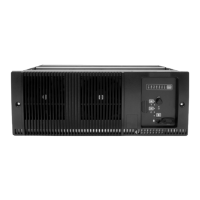50 Network Circuitry TB9100 Reciter Service Manual
© Tait Electronics Limited January 2006
■ asynchronous SRAM
■ synchronous SRAM
■ synchronous burst SRAM
■ asynchronous flash EPROM
■ synchronous burst flash EPROM
■ standard EPROM
■ standard DRAM
■ fast page DRAM
■ EDO DRAM
■ SDRAM
■ most types of bus interfaced peripheral chips, when connected as
memory mapped devices
UPMA is used to control accesses to SDRAM while the GPCM is used to
control accesses to the flash EPROM and the DSP chip, which is classified
as a bus interfaced peripheral. UPMB is not used in the ASIF design.
Each chip select output, CS[0..7]
, has a memory controller assigned to it (see
Tabl e 5 .7) according to the requirements of the device selected by that chip
select. The assignment is controlled via internal MPC registers, which also
allocate a particular address range to a device and sets other parameters such
as address type, bus width, parity enable and write protect.
General-Purpose
Chip Select Machine
The general-purpose chip select machine (GPCM) is normally used for
controlling simple asynchronous memories such as the flash EPROM. It is
also used for controlling the accesses to the DSP host port (see “Host Port
Interface (HPI)” on page 69) and a software strobe output. Hence, the
GPCM is assigned to handle the CS0
, CS2 and CS3 chip select lines.
The GPCM also controls the write enable (WE0
) and read enable (OE)
strobes to the flash EPROM and DSP.
Table 5.7 Chip Select Allocation
Chip Select Output Memory Controller Device
CS0 GPCM Flash EPROM
CS1
UPMA SDRAM
CS2
GPCM DSP
CS3
GPCM software test strobe
CS4
none none
CS5
none none
CS6
none none
CS7
none none

